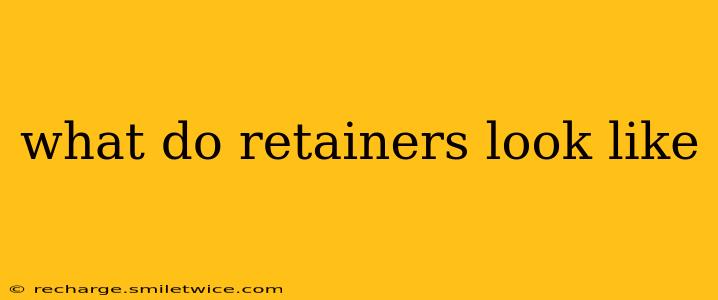What Do Retainers Look Like? A Comprehensive Guide
Dental retainers come in various shapes, sizes, and materials, depending on individual needs and the dentist's recommendations. Understanding the different types can help you better appreciate your own retainer and its role in maintaining your beautiful, straight smile.
What are the different types of retainers?
There are primarily two main types of retainers: removable and fixed. Within these categories, there are further variations in design and materials.
Removable Retainers: These are the most common type and offer flexibility. They can be taken out for cleaning and eating, making them convenient for many patients.
-
Essix Retainers (Clear Retainers): These are made from a thin, clear plastic that is virtually invisible when worn. They are often preferred for their aesthetic appeal and comfort. They look similar to a thin, custom-fitted mouthguard.
-
Hawley Retainers: These are made from a metal wire that fits around the teeth, connected to a clear or pink acrylic base plate. They are more durable than Essix retainers but might be slightly more noticeable. They often have a horseshoe shape with a wire that hugs the teeth.
-
Sports Retainers: While not strictly a retainer type in itself, sports guards can be custom-fitted and used as retainers. This option provides both protection during sporting activities and retention of the teeth's alignment. They often have a more substantial plastic construction than Essix retainers.
Fixed Retainers (Bonded Retainers): These are cemented to the back of the teeth, usually the lower front teeth. They are permanently attached and provide constant retention, ensuring your teeth remain straight.
- Fixed retainers are usually thin wires, almost invisible when the mouth is closed. They’re essentially a small, permanently attached wire on the back of the teeth.
What material are retainers made of?
The materials used in retainer construction greatly influence their appearance and durability.
-
Plastic (Acrylic): Commonly used in Essix and Hawley retainers, it's lightweight, comfortable, and can be made in various colors, though clear is the most popular for aesthetics.
-
Metal (Wire): Used in Hawley retainers and fixed retainers, metal offers superior strength and durability. Stainless steel is the most frequently used metal.
How long do retainers last?
The lifespan of a retainer varies depending on the type and individual care. Removable retainers typically last 1-3 years, while fixed retainers can last much longer, often needing replacement only when damaged or broken.
How do I clean my retainer?
Proper cleaning is crucial for extending the life of your retainer and preventing bacterial buildup. For removable retainers, gentle brushing with a soft-bristled toothbrush and a mild soap is recommended. Avoid using abrasive cleaners or hot water.
What if my retainer breaks?
If your retainer breaks, it's essential to contact your orthodontist immediately. Continuing to wear a broken retainer can affect your teeth's alignment.
What should I do if my retainer doesn't fit comfortably?
If your retainer feels uncomfortable or doesn't fit properly, schedule an appointment with your orthodontist. They can adjust it or provide a new one if necessary. This is crucial to ensure the effectiveness of the retainer and prevent further issues.
Remember, the best way to know what your retainer will look like is to consult with your orthodontist. They can explain the different options available and recommend the best type for your specific needs and preferences. This detailed explanation should provide a clearer picture of what to expect regarding your retainer's appearance and functionality.
